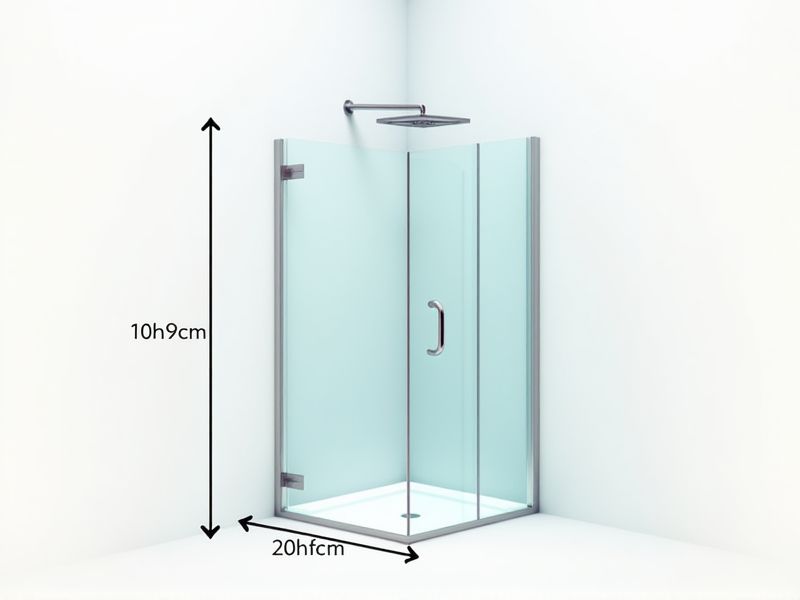
When planning for a walk-in shower, knowing standard dimensions can help ensure comfort and accessibility. Most commonly, walk-in showers are at least 32 inches by 32 inches, but a more generous and recommended size is 36 inches by 36 inches. For even greater ease of movement--especially for those needing wheelchair access--sizes like 48 inches by 36 inches or 60 inches by 36 inches are often preferred. These dimensions strike a practical balance between space efficiency and usability, providing room for features such as benches or grab bars if desired.
Space For Turning
A standard walk-in shower typically requires a minimum space of 36 inches by 36 inches for optimal comfort. This size allows for adequate room for turning and movement, enhancing accessibility, especially for individuals with mobility challenges. Ensuring a clear pathway and a non-slip surface is essential for safety, with a recommendation of at least 60 inches of clearance in front of the shower entrance. Investing in grab bars can further improve your shower experience, offering additional support during use.
Showerhead Height
The recommended showerhead height for a standard walk-in shower is typically set between 76 to 78 inches (193 to 198 cm) from the shower floor, ensuring a comfortable experience for the majority of users. You may also consider adjustable showerheads to accommodate varying heights, particularly for households with diverse members. For optimal water flow, the showerhead should be placed at a slight angle, allowing for a full coverage without excessive splashing outside the enclosure. Ensuring that the showerhead height is correctly installed not only enhances comfort but also provides an effective and enjoyable showering experience.
Door Or Curtain Clearance
A walk-in shower typically requires a minimum door or curtain clearance of 24 to 30 inches for comfortable access. The ideal clearance helps prevent water from splashing outside the shower area, enhancing safety and cleanliness. Ensuring that your shower door swings outward or that your curtain has sufficient overlap can dramatically reduce water leakage. Proper installation and measurements are vital for achieving a functional and aesthetically pleasing walk-in shower design.
Drain Placement
When designing a walk-in shower, the standard drain placement is typically located at the lowest point of the shower floor, ensuring effective water drainage. Most codes recommend a minimum slope of 1% to 2% toward the drain to prevent pooling and ensure efficient water flow. Common drain sizes range from 2 to 4 inches in diameter, accommodating various plumbing configurations and shower sizes. It's essential to consider integrating a linear drain for a modern aesthetic while maintaining optimal drainage efficiency, particularly in larger shower spaces.
Bench Or Seating Space
A well-designed walk-in shower typically incorporates a bench or seating area, enhancing both functionality and comfort. Ideal dimensions for a shower bench are around 36 inches wide and 20 inches deep, providing ample space for relaxation and ease of use. Selecting water-resistant materials, such as teak or composite tiles, ensures durability and an appealing aesthetic. You can elevate your shower experience by installing a curbless entry, allowing seamless access and enhancing safety, especially for individuals with mobility challenges.
Entry And Exit Access
A walk-in shower typically features an entry threshold of 0 to 2 inches, ensuring ease of access for users of all mobility levels. The layout often includes a spacious opening measuring at least 32 inches wide, promoting a seamless transition in and out of the shower. Non-slip flooring is essential, with a minimum coefficient of friction rating of 0.6, to enhance safety during entry and exit. Elevation differences should be minimized, ideally with a smooth, curbless design, to accommodate users with disabilities and enhance overall functionality.
Tile And Material Thickness
When designing a walk-in shower, the choice of tile and material thickness is crucial for durability and aesthetics. Standard ceramic tile typically measures between 8 to 12 millimeters thick, providing a balance between strength and weight. For stone materials, such as granite or marble, thickness often ranges from 12 to 20 millimeters, enhancing their resistance to cracking and wear over time. Selecting the right thickness not only contributes to the longevity of your shower but also affects the overall visual appeal and maintenance requirements.
Shelving Or Storage Areas
A walk-in shower should incorporate effective shelving solutions to enhance usability and organization. Consider installing built-in niches that provide convenient storage for toiletries, keeping them within arm's reach while maintaining an uncluttered space. Wall-mounted shelves can also be an excellent option, allowing you to customize the height and layout based on your needs, ensuring accessibility and efficiency. For optimal functionality, aim for at least 3 to 4 square feet of designated shelving space to accommodate daily essentials without overwhelming the shower environment.
Wheelchair Accessibility
A standard walk-in shower designed for wheelchair accessibility typically includes a minimum width of 36 inches, ensuring easy maneuverability for users. The shower floor should be level with the surrounding bathroom floor, preventing any steps or barriers that could impede access. Slip-resistant tiles with a slight slope toward a central drain are essential to enhance safety and facilitate water drainage. Grab bars installed at a height of 33-36 inches provide stability and support, significantly improving the showering experience for those with limited mobility.
Slope For Proper Drainage
A walk-in shower should have a minimum slope of 1-2% toward the drain, ensuring efficient water drainage and minimizing pooling. This gentle incline, typically achieved by a slope of 1/8 inch per foot, prevents water stagnation and enhances safety by reducing slip risks. Using high-quality materials like ceramic tiles and slip-resistant surfaces can further optimize water flow and overall user experience. For your shower's design, consider integrating a linear drain, as it offers enhanced aesthetics while maintaining effective drainage.
